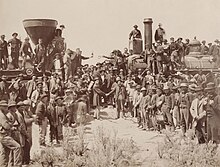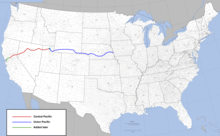Central Pacific Railroad

The Central Pacific Railroad was a railroad company in the western United States . It was created in 1861 and went down in the history of the railroad in North America through its participation in the construction of the first transcontinental rail link . The company was later incorporated into the Southern Pacific Railroad .
Theodore D. Judah , owner of the Sacramento Valley Rail Road, was looking for investors to build a railway line from Sacramento to Virginia (Nevada) . He found them in Collis P. Huntington , Mark Hopkins , Charles Crocker and Leland Stanford . They soon became known as the "Big Four". In June 1861 they founded the Central Pacific Railroad. With the Pacific Railroad Act passed in 1862 , the law to finance and support the construction of the transcontinental railroad link , the Central Pacific Railroad was commissioned to begin construction from the west. The federal government in Washington made corresponding financial aid available for each mile and land built. As a result, the most efficient route was not always chosen.
Construction began in January 1863. Crossing the Sierra Nevada turned out to be the greatest obstacle . With insufficient labor available, over 15,000 Chinese were recruited. The route over the Donner Pass was completed on November 30, 1867. In the period that followed, there was a real competition with the Union Pacific Railroad , as each company wanted to complete as many route kilometers as possible. At times the companies built parallel routes. Finally, it was agreed to carry out the merger at what is now the Golden Spike National Historic Site on the Great Salt Lake in Utah. On May 10, 1869, America's first transcontinental railroad connection was completed.
Theodore Judah and the "Big Four"
Opening up California
In the period that followed, a connection route from Sacramento to Oakland was built over the Altamont Pass and, in 1876, the route network was expanded to Vallejo with the purchase of the California Pacific Railroad . In 1879 a connection between Porta Costa and Oakland was completed. A second connection to Oakland was created together with a train ferry on the Carquinez Strait between Porta Costa and Benicia . The ferries were replaced in 1929 by the Benicia-Martinez Bridge over the bay.
The Central Pacific began to expand its route network to the north at an early stage. In 1870, the Central Pacific acquired the California and Oregon Railroad, which built a route north from Marysville. They continued building this route through Redding along the Sacramento River and over the Siskiyou Range to connect to the Oregon & California Railroad in Ashland, Oregon in 1887. With the acquisition of these companies, the route network could be expanded to Portland . In 1909, a stretch from Black Butte at the foot of Mount Shasta to Klamath Falls was opened .
By 1870, the "Big Four" came into the possession of the San Francisco and San Jose Railroad and the Southern Pacific Railroad . The latter was founded to build a railroad to New Orleans.
After the completion of the transcontinental connection, the company had a quasi-monopoly for rail transport to the east. She consistently exploited this. On the one hand, it got municipalities to make appropriate payments for connections to the rail network, or it set extremely high transport prices. With the financial power she gained from this, she exerted influence on politics and the media. The monopoly was not broken until the Union Pacific and Northern Pacific Railroad reached Portland in the 1880s , and the Atchison, Topeka and Santa Fe Railroad completed their end-to-end connection to California in 1897. At that time, the "Big Four" owned over 400 different companies that were active in all areas of infrastructure development, including transportation, land, water, oil and agriculture, so the company's influence on the California economy continued for a long time. Frank Norris wrote his novel "The Octopus: A Story of California" based on these activities.
Until 1884 Central Pacific and Southern Pacific were two independent companies, but both were controlled by the same people (Big Four) and were therefore operated as one system. In order to simplify social relations, the Southern Pacific Company was founded, which replaced the Southern Pacific Railroad. The Central Pacific Railroad leased their property to the SP and reorganized as the Central Pacific Railway. In 1901, the Union Pacific Railroad, led by EH Harriman, took control of the Southern Pacific. As a result, the aging Central Pacific route, in particular, was modernized. Among other things, the Lucin Cutoff was built through the Great Salt Lake.
Through efforts of the President of the USA Theodore Roosevelt in 1912 to limit the power of monopoly companies by means of the Sherman Antitrust Act , it was demanded that Southern Pacific and Union Pacific should separate again. Since the Central Pacific stretch from Ogden to Oakland was particularly important for the Union Pacific, the aim was to separate the Southern Pacific and Central Pacific. However, this step was prevented by the California government. In contrast to the opinion of the public and politics, which saw the railway company as Kraken, this prevented the breakdown of their monopoly in California.
The Central Pacific was provisionally managed by the Southern Pacific until April 21, 1959. Only then could the Southern Pacific take over the Central Pacific completely.
The Central Pacific Railroad was added to the List of National Historic Civil Engineering Landmarks by the American Society of Civil Engineers in 1968.
Web links
- Martin Herzog: May 10, 1869 - First transcontinental railroad in the USA . WDR ZeitZeichen (podcast).
literature
- Gordon H. Chang, Shelley Fisher Fishkin (Eds.): The Chinese and the Iron Road: Building the Transcontinental Railroad. Stanford University Press, Stanford 2019, ISBN 978-1-5036-0925-9 .
Individual evidence
- ^ A b Ceremony at "Wedding of the Rails," May 10, 1869 at Promontory Point, Utah from world digital library, accessed September 16, 2013





